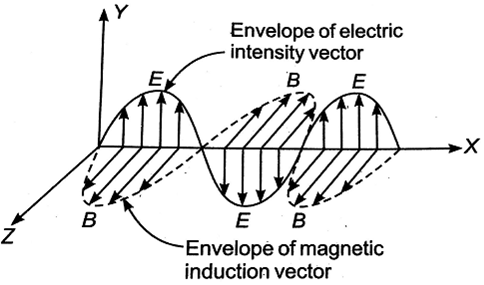Electromagnetic Waves
Sponsor Area
The condition under which a microwave oven heats up a food item containing water molecules most efficiently is
-
the frequency of the microwave must match the resonant frequency of the water molecules
-
the frequency of the microwave has no relation with natural frequency of water molecules
-
microwave are heat waves, so always produce heating
-
infrared waves produce heating in a microwave oven
A.
the frequency of the microwave must match the resonant frequency of the water molecules
It is an electromagnetic wave, therefore the correct choice is (a).
Sponsor Area
The decreasing order of wavelength of infrared, microwave, ultraviolet and gamma rays is
-
gamma rays, ultraviolet, infrared, microwaves
-
microwaves, gamma rays, infrared, ultraviolet
-
infrared, microwave, ultraviolet, gamma rays.
-
microwave infrared, ultraviolet, gamma rays
D.
microwave infrared, ultraviolet, gamma rays
Decreasing order of the wavelength of various rays.
Microwave > infrared > Ultraviolet > Gamma
The electric and magnetic field of an electromagnetic wave are:
-
in phase and parallel to each other
-
in opposite phase and perpendicular to each other
-
in opposite phase and parallel to each other
-
in phase and perpendicular to each other
D.
in phase and perpendicular to each other
Electromagnetic waves are those waves in which there are a sinusoidal variation of electric and magnetic field vectors at right angles to each other as well as right angles to the direction of wave propagation.
The sinusoidal variation in both electric and magnetic field vectors ( occurs, simultaneously. As a result, they attain the maxima and minima at the same place and at the same time. The amplitudes of the electric and magnetic fields in free spaces are related by
occurs, simultaneously. As a result, they attain the maxima and minima at the same place and at the same time. The amplitudes of the electric and magnetic fields in free spaces are related by
In the figure, electric field vector and magnetic field vector (
magnetic field vector ( ) are vibrating along Y and Z directions and propagation of the electromagnetic wave is shown in X -direction.
) are vibrating along Y and Z directions and propagation of the electromagnetic wave is shown in X -direction.
Hence, electric and magnetic fields are in phase and perpendicular to each other.
The electric field associated with an electromagnetic wave in vacuum is given by E=i 40 cos (kz-6x108t), where E, z= and t are in volt/m, metre and second respectively. The value of wave vector k is
-
2 m-1
-
0.5 m-1
-
6 m-1
-
3 m-1
A.
2 m-1
Electromagnetic wave equation 
The energy of the EM waves is of the order of 15 keV. To which part of the spectrum does it belong?
-
X - rays
-
infrared rays
-
Ultraviolet rays
-
gamma -rays
A.
X - rays
Given, energy of EM waves is of the order of 15 keV
Sponsor Area
Mock Test Series
Mock Test Series





